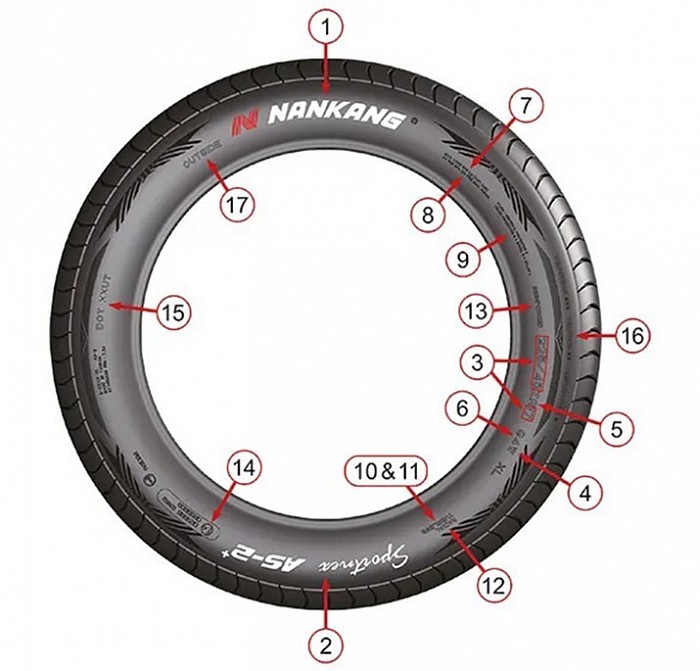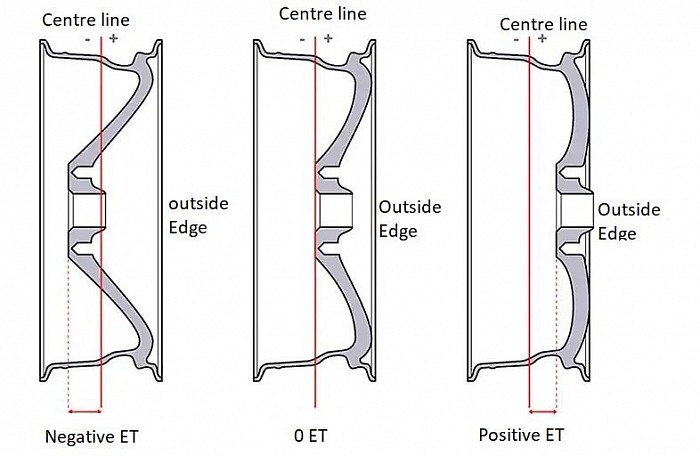Tyre Information Explained
Please click below to access a wheel / tyre sizing calculator. There is also a handy app that you can download to find sizing for your specific vehicle make and model.
To return to this website, just click the back button.
If you have any questions about product sizing and availability, please contact us.
TYRE SIZE MARKINGS
The tyre size designation is usually, for example, 195/70 R 14 84 T and means the following:
1. Manufacturer name (brand)
2. Tyre model name.
3. Tyre size marking
4. Speed marking
5. Construction type
6. Load class (LI)
7. Maximum load capacity (1 LBS; 0.454 kg)
8. Maximum load pressure (1 PSI; 6.9 kPa)
9. Fabric material + (number of layers on the side and tread) - ply rating
10/11. Tubeless Inner ring
12. Radial ring in occurring cases
13. Reinforced (reinforced tire / load capacity greater than 4 LI)
14. Special mark (eg E-approval number)
15. DOT mark (Department of Transportation). Indicates the time of manufacture of the tire in four digits. The first 2 issues indicate the week of manufacture of the tires and the next 2 years of manufacture.
16. UTQG (Uniform Tire Quality Grading)
17. The tire usually has either an OUTSIDE marking on the outward side or an arrow pattern indicating the direction of rotation of the tire.
The most common tyre speed classes:
F = 80 km/h = 50mph
J = 100 km/h = 63mph
L = 120 km/h = 75mph
M = 130 km/h = 81mph
N = 140 km/h = 87mph
P = 150 km/h = 94mph
Q = 160 km/h = 100mph
R = 170 km/h = 106mph
S = 180 km/h = 112mph
T = 190 km/h = 118mph
U = 200 km/h = 125mph
H = 210 km/h = 131mph
V = 240 km/h = 150mph
Z = more than 240 km/h = 150+mph
W = 270 km/h = 168mph
Y = 300 km/h = 187mph
Maximum Tyre Load - Load Index
The Load Index (LI) indicates the maximum permissible load capacity of the tyre. In a normal passenger car, the load capacity of the tyre must be at least a quarter of the total weight of the car. If the axle masses are marked separately on the registration certificate, the capacity must be at least half of the axle mass.
The most common load classes:
60 = 250kg
61 = 257kg
62 = 265kg
63 = 272kg
64 = 280kg
65 = 290kg
66 = 300kg
67 = 307kg
68 = 315kg
69 = 325kg
70 = 335kg
71 = 345kg
72 = 355kg
73 = 365kg
74 = 375kg
75 = 387kg
76 = 400kg
77 = 412kg
78 = 425kg
79 = 437kg
80 =450kg
81 = 462kg
82 = 475kg
83 = 487kg
84 = 500kg
85 = 515kg
86 = 530kg
87 = 545kg
88 = 560kg
89 = 580kg
90 = 600kg
91= 615kg
92 = 630kg
93 = 650kg
94 = 670kg
95 = 690kg
96 = 710kg
97 = 730kg
98 = 750kg
99 = 775kg
100 = 800kg
101 = 825kg
102 = 850kg
103 = 875kg
104 = 900kg
105 = 925kg
106 = 950kg
107 = 975kg
108 = 1000kg
109 = 1030kg.
110 = 1060kg
111 = 1090kg
112 = 1120kg
113 = 1150kg
114 = 1180kg
115 = 1215kg
116 = 1250kg
117 = 1285kg
118 = 1320kg
119 = 1360kg
121= 1450kg
122 = 1500kg
123 = 1550kg
124 = 1600kg
125 = 1650kg
126 = 1700kg
127 = 1750kg
128 = 1800kg
129 = 1850kg
130 = 1900kg
131= 2050 kg
133 = 2060kg
134 = 2120kg
135 = 2180kg
136 = 2240kg
137 = 2300kg
138 = 2360kg
139 = 2430kg
140 = 2500kg
141 = 2575kg
142 = 2650kg
143 = 2725kg
144 = 2800kg
145 = 2900kg
146 = 3000kg
147 = 3075kg
148 = 3150kg
149 = 3250kg
150 = 3350kg
151 = 3450kg
152 = 3550kg
153 = 3650kg
154 = 3750kg
155 = 3875kg
156 = 4000kg
157 = 4125kg
158 = 4250kg
159 = 4375kg
160 = 4500kg
161 = 4625kg
162 = 4750kg
163 = 4875kg
164 = 5000kg
165 = 5150kg
166 = 5300kg
167 = 5450kg
168 = 5600kg
169 =5800kg
171 = 6150kg
172 = 6300kg
173 = 6500kg
174 = 6700kg
175 = 6900kg
176 = 7100kg
177 = 7300kg
178 = 7500kg
179 = 7750kg
180 = 8000kg
Rim ET/Offset
6- and 8-bolt ones are modified in the same way as 4-bolt ones.
ET = Offset = Distance from the rim mounting flange to the rim centreline in millimeters.
Positive offset: The mounting flange is outer than the rim centreline, as shown in the picture.
Offset 0: The mounting flange is aligned with the centre line of the rim, as shown in the picture.
Negative offset: The mounting flange is inner than the rim centreline, as shown in the picture.
Rim size conversion
Inches to Millimetres - change table
Inches - Millimetres
4 x 3.93 - 4 x 100
4 x 4.25 - 4 x 107.95
4 x 4.33 - 4 x 110
4 x 4.50 - 4 x 114.3
4 x 5.12 - 4 x 130
4 x 5.5 - 4 x 139.7
4 x 6.5 - 4 x 165.15
5 x 4.00 - 5 x 100
5 x 4.25 - 5 x 107.95
5 x 4.50 - 5 x 114.3
5 x 4.53 - 5 x 115
5 x 4.72 - 5 x 120
5 x 4.75 - 5 x 120.65
5 x 5.00 - 5 x 127
5 x 5.12 - 5 x 130
5 x 5.50 - 5 x 139.7
5 x 6.00 - 5 x 152.4
5 x 6.50 - 5 x 165.15
6 x 4.50 - 6 x 114.3
6 x 5.00 - 6 x 127
6 x 5.50 - 6 x 139.7
6 x 6.00 - 6 x 152.4
6 x 6.50 - 6 x 165.15
8 x 6.50 - 8 x 165.1



